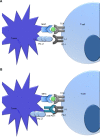Clinical applications of PD-1-based therapy: a focus on pembrolizumab (MK-3475) in the management of melanoma and other tumor types
- PMID: 25960664
- PMCID: PMC4410900
- DOI: 10.2147/OTT.S53164
Clinical applications of PD-1-based therapy: a focus on pembrolizumab (MK-3475) in the management of melanoma and other tumor types
Abstract
Preclinical work has led to an increased understanding of the immunomodulatory mechanisms involved in the regulation of the antitumor response in a variety of tumor types. PD-1 (programmed death 1) appears to be a key checkpoint involved in immune suppression in the tumor microenvironment, even in diseases not previously thought to be sensitive to immune manipulation. More recently, the subsequent clinical development of PD-1-based therapy has resulted in a major breakthrough in the field of oncology. Pembrolizumab, a humanized highly selective IgG4 anti-PD-1 monoclonal antibody, was recently approved for the treatment of advanced melanoma based on promising early-phase clinical data. Encouraging results have also been seen in other malignancies, and PD-1-targeted therapies are likely to markedly change the treatment landscape. Future work will center on rationally designed combination strategies in order to potentiate the antitumor immune response and overcome mechanisms of resistance.
Keywords: PD-1; antitumor activity; cancer; immunotherapy; nivolumab; pembrolizumab.
Figures

Similar articles
-
The Next Immune-Checkpoint Inhibitors: PD-1/PD-L1 Blockade in Melanoma.Clin Ther. 2015 Apr 1;37(4):764-82. doi: 10.1016/j.clinthera.2015.02.018. Epub 2015 Mar 29. Clin Ther. 2015. PMID: 25823918 Free PMC article. Review.
-
Pembrolizumab: PD-1 inhibition as a therapeutic strategy in cancer.Drugs Today (Barc). 2015 Jan;51(1):7-20. doi: 10.1358/dot.2015.51.1.2250387. Drugs Today (Barc). 2015. PMID: 25685857 Review.
-
Pembrolizumab for the treatment of thoracic malignancies: current landscape and future directions.Future Oncol. 2016 Jan;12(1):9-23. doi: 10.2217/fon.15.294. Epub 2015 Dec 3. Future Oncol. 2016. PMID: 26631501 Review.
-
[Development of immune checkpoint inhibitors].Rinsho Ketsueki. 2017;58(8):966-976. doi: 10.11406/rinketsu.58.966. Rinsho Ketsueki. 2017. PMID: 28883282 Japanese.
-
Programmed death-1 & its ligands: promising targets for cancer immunotherapy.Immunotherapy. 2015;7(7):777-92. doi: 10.2217/imt.15.49. Epub 2015 Aug 7. Immunotherapy. 2015. PMID: 26250412 Review.
Cited by
-
Expression and clinical significance of programmed death-1 on lymphocytes and programmed death ligand-1 on monocytes in the peripheral blood of patients with cervical cancer.Oncol Lett. 2017 Dec;14(6):7225-7231. doi: 10.3892/ol.2017.7105. Epub 2017 Sep 29. Oncol Lett. 2017. PMID: 29344157 Free PMC article.
-
Fundamental effects of PD-1 antibody on the body: a brief report.Onco Targets Ther. 2016 Jul 7;9:4137-41. doi: 10.2147/OTT.S104766. eCollection 2016. Onco Targets Ther. 2016. PMID: 27462168 Free PMC article.
-
Case report: Reproductive organ preservation and subsequent pregnancy for an infertility patient with lynch syndrome-associated synchronous endometrial cancer and colon cancer after treatment with a PD-1 checkpoint inhibitor.Front Immunol. 2022 Oct 17;13:1010490. doi: 10.3389/fimmu.2022.1010490. eCollection 2022. Front Immunol. 2022. PMID: 36325347 Free PMC article.
-
Effects of exosomes on pre-metastatic niche formation in tumors.Mol Cancer. 2019 Mar 11;18(1):39. doi: 10.1186/s12943-019-0995-1. Mol Cancer. 2019. PMID: 30857545 Free PMC article. Review.
-
EP4 as a Therapeutic Target for Aggressive Human Breast Cancer.Int J Mol Sci. 2018 Mar 29;19(4):1019. doi: 10.3390/ijms19041019. Int J Mol Sci. 2018. PMID: 29596308 Free PMC article. Review.
References
-
- Rosenberg SA, Yang JC, Topalian SL, et al. Treatment of 283 consecutive patients with metastatic melanoma or renal cell cancer using high-dose bolus interleukin 2. JAMA. 1994;271(12):907–913. - PubMed
-
- Kirkwood JM, Strawderman MH, Ernstoff MS, Smith TJ, Borden EC, Blum RH. Interferon alfa-2b adjuvant therapy of high-risk resected cutaneous melanoma: the Eastern Cooperative Oncology Group Trial EST 1684. J Clin Oncol. 1996;14(1):7–17. - PubMed
-
- Kantoff PW, Higano CS, Shore ND, et al. Sipuleucel-T immunotherapy for castration-resistant prostate cancer. N Engl J Med. 2010;363(5):411–422. - PubMed
Publication types
LinkOut - more resources
Full Text Sources
Other Literature Sources

